How to Start an eCommerce Business in Canada

If you ask your friends and family, almost everyone will show an interest in setting up an eCommerce business. After all, it promises high returns. Secondly, with consumers finding online shopping more convenient than in-store, eCommerce is booming. On top of it, running an online store is relatively easier compared to a traditional or offline business. The finances required to set a store are quite low.
With low barriers to entry and ever-increasing popularity, it is the perfect time to start an eCommerce business. Nevertheless, there is no guarantee of success. This article discusses everything there is to know about starting an eCommerce business in Canada. After reading this guide, you’ll be able to make an informed decision and improve the likelihood of success by a significant amount.
Some Stats About eCommerce in Canada
Before we discuss the ‘how’ part, let’s quickly go through some interesting statistics about eCommerce in Canada.
The figure below shows the reason why people prefer online shopping compared to in-store.
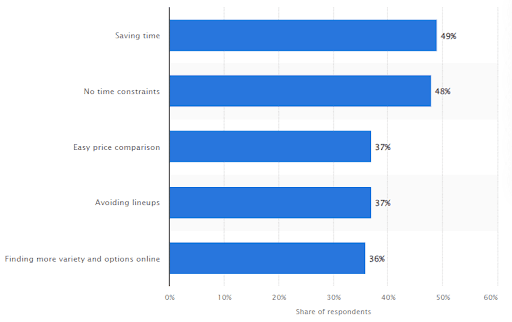
As you can see, the top reason people prefer online shopping is because it saves time. Secondly, whether it is 2 am in the morning or any other time of the day, you can order the desired product. There is no need to wait for the store to open nor visit it physically. Thirdly, one can compare prices online. This is not possible when shopping physically. You would need to visit each store to find the price and then compare it from other stores.
The below figure shows the most popular payment channels in Canada.
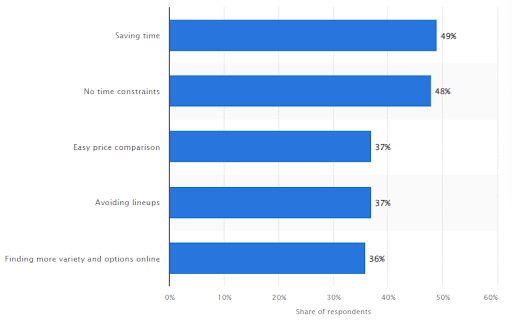
Credit card is the most popular payment channel. The likely reason is the rewards programs associated with credit cards. It compels users to use the card as much as possible.
The below statistic shows the most important factors for online shopping in Canada.
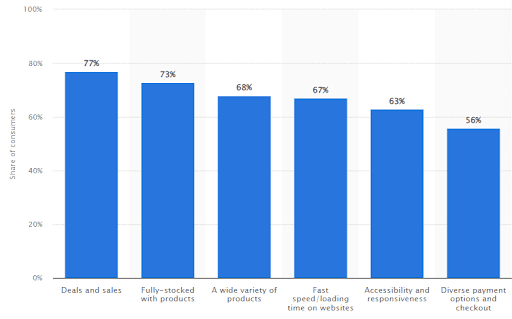
Everyone loves to save money. Thus, the topmost important factor is ‘Deals and Sales’. Therefore, when developing your marketing strategy, think about the different ways you can help consumers save money.
No doubt that eCommerce is popular in Canada. But what is the precise number? The below statistic sheds light on it.
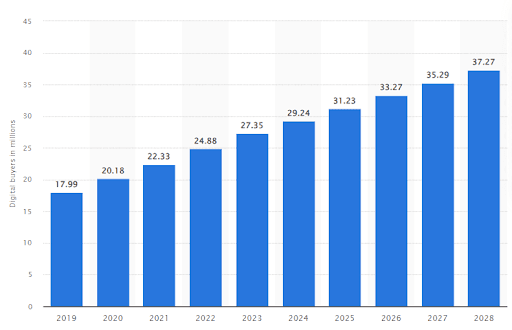
As is evident, the number of online buyers is steadily increasing with each passing year. Currently, there are 29.24 million people who have engaged in eCommerce purchases. What do Canadians purchase the most? Based on the below figure, clothing is the most popular purchase.

Which stores do Canadians rely on for online shopping? Let’s take a look.
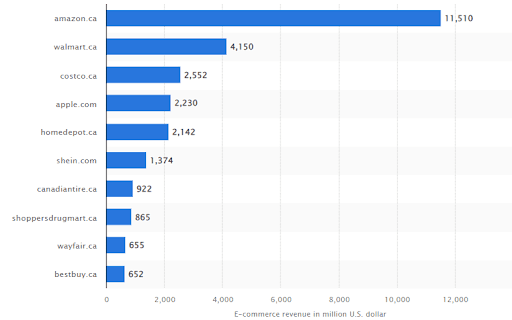
Given the reach of Amazon, it is only natural that it is the most popular eCommerce store in Canada. As the statistic shows, it is miles ahead of the other platforms. One reason is that unlike other stores, Amazon is a one-stop-shop for everything. It does not focus on specific products. Instead, it offers every product imaginable.
If you are still having doubts regarding the feasibility of eCommerce business, check out the value of eCommerce retail in Canada.
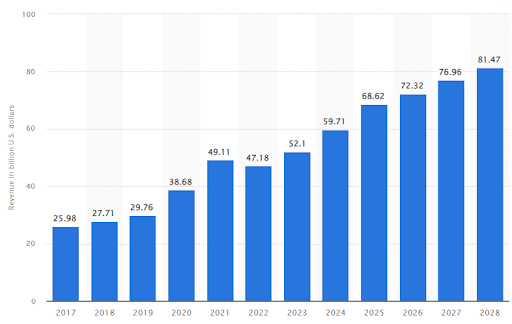
eCommerce is showing no signs of slowing down. It is set to increase with each year. Hence, we recommend that you go through with your plan of setting up an online store. With our guide, you can achieve success.
Setting up an eCommerce Business in Canada
1. Decide the eCommerce Model
The first thing you need to decide is the eCommerce model. Like in any other business, there are four main options – business to consumer (B2C), business to business (B2B), consumer to business (C2B), and consumer to consumer (C2C). We will not delve into the models in detail as they are self-explanatory.
You must spend as much time as possible at this stage. Read industry reports and other sources of information to determine which model you would like to opt for. For starters, we recommend sticking to one model only. Don’t opt for multiple models as it can be quite overwhelming.
Remember, when talking about an eCommerce business, we are not referring to dropshipping. Although it is a form of eCommerce, this guide is about an eCommerce business where you have full control over every aspect of the store. If you are considering a dropshipping business, refer to our guide on ‘How to Start a Dropshipping Business in Canada’.
2. Finalise the Product(s)
Once you decide the eCommerce model, the next step is to finalise the product(s). Again, take as much time as possible. Don’t rush the decision. If you do so, it will have long-term repercussions. Based on our experience as an eCommerce development company, there are different ways to go about when finalizing the product. The first option is to select the most popular or demanded products.
You can get an idea about such products by visiting the top eCommerce websites. You will find a tab such as ‘best sellers’, ‘in demand’, ‘top sellers’, or anything similar. For instance, Amazon.ca has a best seller tab as shown below.

Once you click on this tab, you will come across countless products that have high sales. You can use this information to finalise products for your own store. The second option is to target a niche market. Identify a market that is different from the wider target audience. Research what makes them different or what value are they looking for in a product. Then, engage the manufacturer/seller to design a product that meets their requirements effectively.
The third option would be to get a product and then create a demand for it. Apple’s iPhone is the perfect example of it. People did not know that they needed an iPhone. But after manufacturing the product, Apple created a demand for it. Today, Apple has one of the most loyal customers and is amongst the world’s most valuable companies. Engage your friends and family when finalizing the product(s). Their input is invaluable and can help you refine your products further.
If you are lost and don’t know where to start, we recommend logging into a keyword planner tool. These tools show the search volume against the entered keyword. It gives you an idea about the number of people searching for the specified product. Google Keyword Planner is a free tool and one of the most effective ones. The below image shows the search volume for leather boots + hiking boot. We have limited the search to Toronto, Canada only.
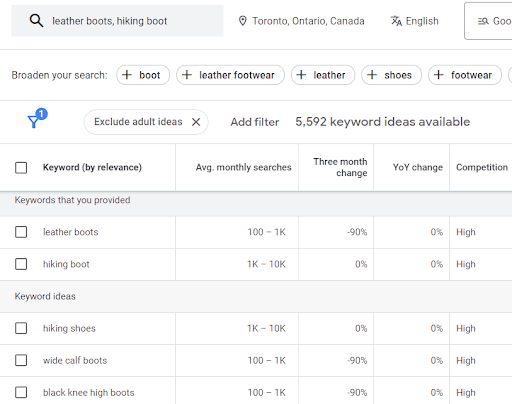
As you can see from the image, leather boots have a monthly average search volume of 100 – 1000. For hiking boot, it is 1,000 – 10,000. You can enter your product to assess the search volume for it. Once you finalise the product, ensure that you only source the product from the top-rated sellers/distributors/manufacturers. Any lapse in product quality will undermine consumer trust in your store. So, always stick to the most reliable ones.
3. Business Registration
The next step is to register your business. We recommend that you choose a business name for which the domain name is available. Although there are no restrictions on having a business name which is separate from the domain name, it can prove problematic from the marketing perspective. You don’t need to have the full name as the URL. It can be an abbreviation. Ensure that the URL is easy to read and search engine friendly.
Shopify has developed a comprehensive guide on selecting a domain name. Go through it to avoid common mistakes associated with domain name selection. Once you finalise the business name, register it with the relevant authorities. Remember, even online businesses need a license to operate.
4. Selecting the eCommerce Platform
The next step is to select the eCommerce platform. As a leading eCommerce website development company in Toronto, we have experience in Shopify, Magento, WooCommerce, and numerous other platforms. Each platform has its pros and cons. Thus, selecting the right platform is not a straightforward decision. There are various factors to consider.
We recommend you share your requirements with us. Based on your needs, we can help you make the right decision. Furthermore, we have conducted an in-depth comparison of Shopify and Magento, the world's top two eCommerce platforms. Go through it as we have covered the topic from every perspective.
5. Designing the Store
After selecting the eCommerce platform, the next step is to work on the design and functionality. Hire an eCommerce development company for this purpose. With tones of experience under their belt, they can design a store that is tailored to your needs. A highly customized store is a great way to differentiate yourself from the competition and create brand value.
Whether it is Shopify, Magento, Shopify, or any other platform, you can find ready-made designs (templates). You can select them if you don’t have the budget for custom development. Once your store starts generating income, you can focus on custom website development.
6. Engaging Content
Once the design is complete, you need to upload content. The text needs to incorporate primary and secondary keywords. The images need to complement the text and vice versa. Remember that everything needs to be unique. If you use pirated images and duplicate content, your website will be penalized. It won’t appear on the rankings and it can be near impossible to recover from a penalty.
7. Must-Have Tools
After setting up the website and uploading the products, you need to add additional tools. Depending on the platform, some of these tools may come pre-installed or you may need a connector to integrate them within the platform. These tools range from marketing software to analytics. Let’s see what tools you need.
After setting up the website, you need to create content. Without content, there is no way to optimise your store for the search engines or increase visibility. For content creation, you can use ChatGPT, Canva, and other similar tools. Then you need a tool for internal communication. You can use Slack for this purpose.
Furthermore, sales and logistics is perhaps the most important part of any online business. There are various tools to handle this aspect of the store. You need to search around for which tool fits your requirements and budget. For marketing, you can opt for MailChimp (email marketing, Ahrefs (search engine optimization), and Buffer (social media marketing).
For analytics, Google Analytics is a very handy tool. It is free and serves multiple purposes. You need a tool that helps you manage your customers. In other words, you need a customer relationship management (CRM) software. A CRM helps attract new customers and retain existing ones. Zendesk is quite powerful when it comes to CRM software. Try the trial version before making any purchase.
Lastly, integrate payment processors with your store. We have already discussed the most widely used payment channels in Canada. Try to offer the maximum number of options to the customers as it will have a positive impact on your sales. Remember, when you facilitate your customers, they reward you by showing increased loyalty. In eCommerce where competition is quite high, developing brand loyalty should be a top priority.
8. Test Run
Once everything is set up and all necessary tools are integrated, conduct a test run. It will help you identify any possible issues and take corrective actions. The last thing you want is to leave a store that is full of bugs. It will undermine consumer trust in your store and it can be very challenging to regain that trust. Thus, ensure that the store is bug-free before making it live.
9. Go Live
Once all errors are resolved, go live. Start marketing the store. Work on search engine optimization, social media marketing, paid advertising, email campaigns, and everything else which fits your budget. Generate the maximum buzz possible. Do keep track of the performance metrics. Assess which marketing campaign has proven to be the most effective.
Over time, increase its budget while reducing the budget for other campaigns. After all, there’s no point in running a campaign which does not generate the required number of leads. Nevertheless, don’t rush into any decision. Marketing requires considerable patience. You will need to keep optimizing the strategies until you find the right fit. Till then, keep experimenting.
10. Continuous Improvement
Lastly, keep improving your store. Listen to the customer feedback regarding the products, customer service, and other areas. Ensure that you respond to feedback (positive and negative) effectively. As trends keep changing, so should your approach. Add new products when required. Likewise, improve your website with new functionality and design as needed. It will help you stay relevant and ahead of the competition.
Conclusion
It concludes our article on how to start an eCommerce business in Canada. We have covered every aspect possible. If you have any queries or require help with setting up an eCommerce store in Canada, contact us. With our expertise and experience, we can provide you with the competitive edge that is required to thrive in the world of eCommerce.
